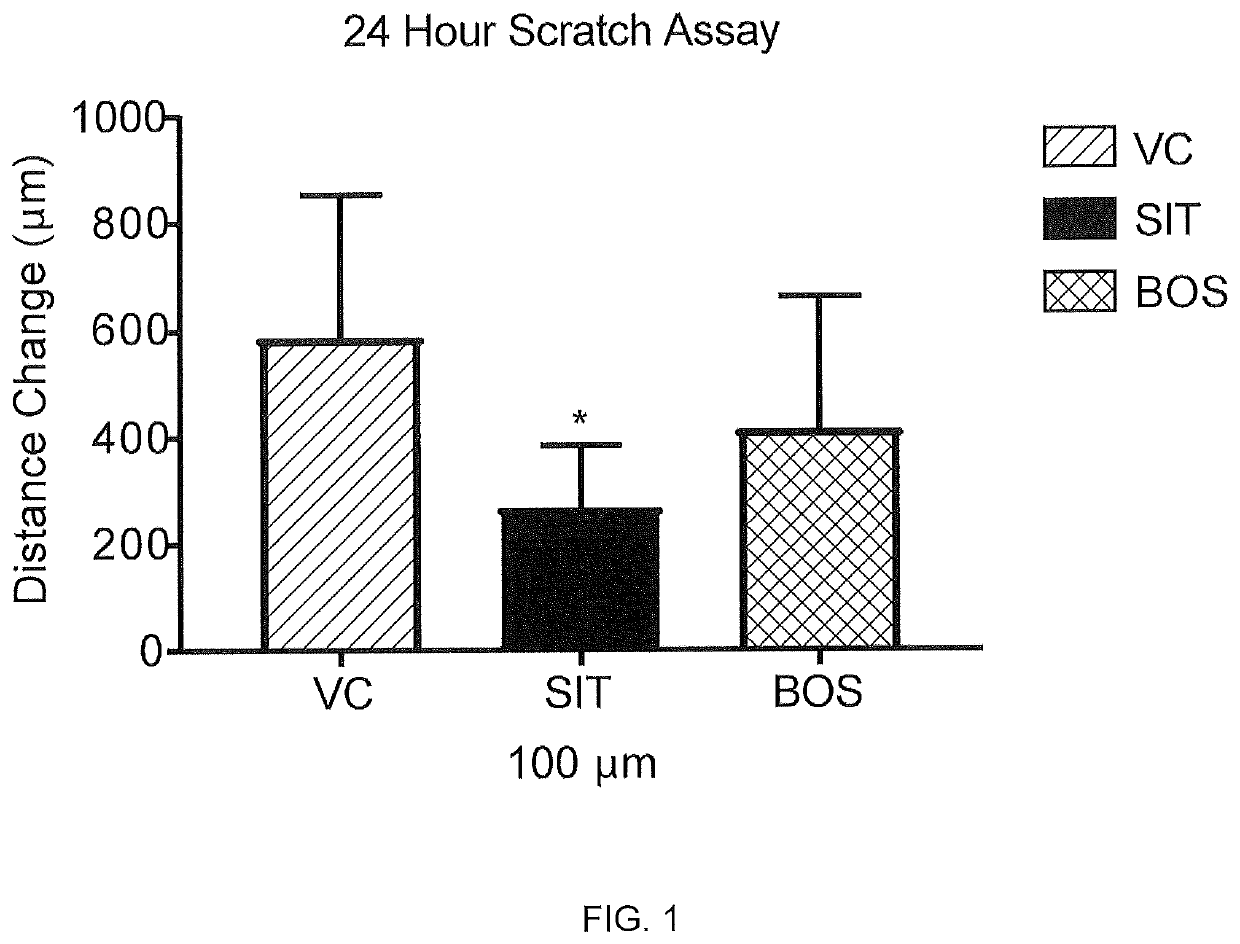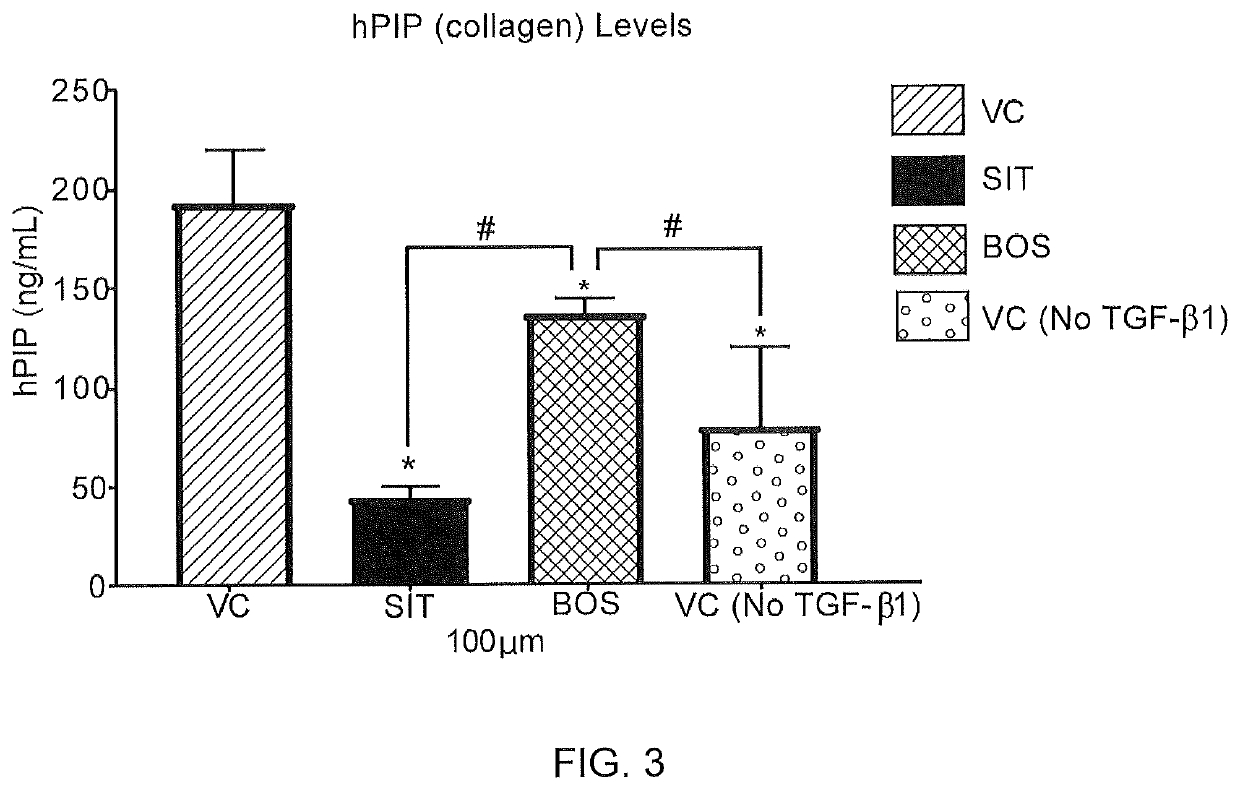Compositions and methods for treating cutaneous fibrosis
- Summary
- Abstract
- Description
- Claims
- Application Information
AI Technical Summary
Benefits of technology
Problems solved by technology
Method used
Image
Examples
example 1
Effect of Sitaxentan on TGF-β1 Induced Fibroblasts in Male Cells
[0124]The effect of sitaxentan in a wound closure assay was measured using male normal human dermal fibroblasts induced with TGF-β1 into a profibrotic phenotype. Scleroderma fibroblasts “close” the wound in a scratch assay significantly faster than controls, and these induced fibroblasts behave similarly to scleroderma fibroblasts in a 2-dimensional scratch assay. For this assay the cells were grown to confluence, a scratch / ablation, i.e. “wound”, was created, and migration across the cleared zone was tracked. See, http: / / journals.plos.org / plosone / article?id=10.1371 / journal.pone.0007438 and Wu, M. et al. Rosiglitazone abrogates bleomycin-induced scleroderma and blocks profibrotic responses through peroxisome proliferator-activated receptor-gamma. Am J Pathol174, 519-533, doi:10.2353 / ajpath.2009.080574 (2009)
[0125]Male normal human dermal fibroblast cells (LLCT FC0024 lot 03869_male fibroblast, 23 year old) were seeded t...
example 2
Effect of Sitaxentan on TGF-β1 Induced Fibroblasts in Female Cells
[0139]The effect of sitaxentan in a wound closure assay was measured using female normal human dermal fibroblasts induced with TGF-β1 into a profibrotic phenotype. Scleroderma fibroblasts “close” the wound in a scratch assay significantly faster than controls, and these induced fibroblasts behave similarly to scleroderma fibroblasts in a 2-dimensional scratch assay. For this assay the cells were grown to confluence, a scratch / ablation, i.e. “wound”, was created, and migration across the cleared zone was tracked. See, http: / / journals.plos.org / plosone / article?id=10.1371 / journal.pone.0007438 and Wu, M. et al. Rosiglitazone abrogates bleomycin-induced scleroderma and blocks profibrotic responses through peroxisome proliferator-activated receptor-gamma. Am J Pathol174, 519-533, doi:10.2353 / ajpath.2009.080574 (2009)
[0140]Female normal human dermal fibroblast cells (LLCT FC0024 lot 00703_female fibroblast, 45 year old) were ...
example 3
Effect of Sitaxentan on Collagen Production in TGF-β1 Induced Human Dermal Fibroblasts
[0154]The effect of sitaxentan on collagen production was measured in an AlphaLISA assay using male normal human dermal fibroblasts induced with TGF-β1 into a profibrotic phenotype. For this assay cells were grown for 48 hours in the presence of vehicle control, sitaxentan, and bosentan. See, http: / / www.perkinelmer.com / product / alphalisa-hpip-collagen-kit-100pts-al353hv.
[0155]An AlphaLISA assay was used, which is a variation of FRET (Fluorescence resonance energy transfer) technology that allows for the detection of molecules of interest in a no-wash, highly sensitive, quantitative assay. In an AlphaLISA assay, a biotinylated anti-analyte antibody binds to Streptavidin-coated donor beads while another anti-analyte antibody is conjugated to AlphaLISA Acceptor beads. In the presence of the analyte, the beads come into close proximity. The excitation of the donor beads cause the release of singlet oxyg...
PUM
| Property | Measurement | Unit |
|---|---|---|
| Weight | aaaaa | aaaaa |
| Fraction | aaaaa | aaaaa |
| Fraction | aaaaa | aaaaa |
Abstract
Description
Claims
Application Information
 Login to View More
Login to View More - R&D
- Intellectual Property
- Life Sciences
- Materials
- Tech Scout
- Unparalleled Data Quality
- Higher Quality Content
- 60% Fewer Hallucinations
Browse by: Latest US Patents, China's latest patents, Technical Efficacy Thesaurus, Application Domain, Technology Topic, Popular Technical Reports.
© 2025 PatSnap. All rights reserved.Legal|Privacy policy|Modern Slavery Act Transparency Statement|Sitemap|About US| Contact US: help@patsnap.com



